TS Board Telangana SCERT Class 8 Physics Solutions 6th Lesson Reflection of Light at Plane Surfaces Textbook Questions and Answers.
TS 8th Class Physics 6th Lesson Questions and Answers – Reflection of Light at Plane Surfaces
I. Reflections on concepts.
Question 1.
If a ray incidents normally on a plane mirror, what will be the angle of reflection?
Answer:
When the incident ray comes along normal it
bounces back in same direction
Here i = 0
r=0
where i → Angle of incidence
r → Angle of reflection
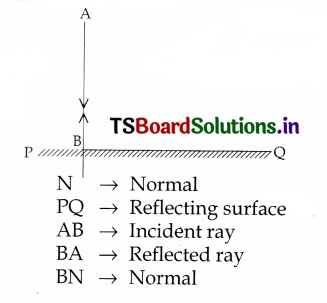
Question 2.
Explain the laws of reflection’?
Answer:
Laws of reflection:
1st Law: The angle of incidence is equal to the angle of reflection.
2nd Law: The incident ray, the normal, and the reflected ray lie in the same plane.
Question 3.
Explain the process of formation of an image with a pinhole camera? Draw a ray diagram to show this.
Answer:
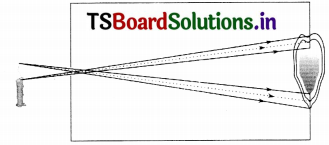
- The light from the candle travels straight in all directions from each point of the flame of the candle.
- But only the light coming in some particular direction can enter into the camera through its pinhole.
- Light which comes from the point at the bottom of the flame goes straight towards the top of the screen.
- In this way the light coming in a particular direction from each point of the flame will be able to enter into the pinhole and light going in other direction is blocked by the black sheet.
- This leads to the formation of inverted image on the screen.
Question 4.
Why does the image in plane mirror suffers lateral inversion?
Answer:
- Take an object before a plane mirror.
- The light rays which come from right side of the object reach the plane mirror.
- The reflected ray reaches our eye.
- But our brains feels that the ray is coming from the inside of the mirror.
- That is why the right side of the object looks like left side in the image.
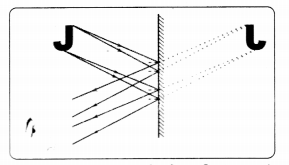
Question 5.
Draw a ray diagram to understand the formation of image for a pointed object by a plane mirror’? Explain it.
Answer:
‘O’ is a point object. Some rays from ‘O’ reach the mirror and get reflected.
When we look into the mirror, the reflected rays seem to be coming from the point I.
So point I is the image of point object O’.
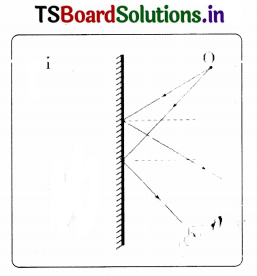
II. Application of concepts
Question 1.
In the adjacent figure, AO and OB are incident and 90° reflected rays respectively. ∠AOB = 90°. Find the values of angle of incidence and angle of reflection?
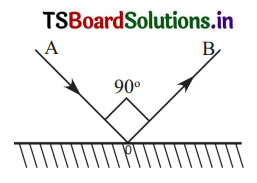
Answer:
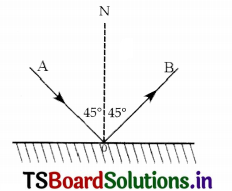
To find the angle of incidence and angle of reflection we should draw a normal at
the point of Indicence “O”. It bisects 90° into 45° and 45°. N
∴Angle of incidence “i” = 45
Angle of reflection “r” = 45
Question 2.
Bharath stands in front of a plane mirror at a distance of 5m. from the mirror and observes his image in the mirror. If he moves 2m. towards the plane mirror, then what will be the distance between Bharath and his image?
Answer:
The distance of Bharath and mirror, in the beginning, is 5m Now he walks 2 m towards the mirror.
Then he is at a distance 3m from the mirror (∵ 5 – 2 = 3 m)
Then the image distance behind the mirror is also 3 m.
The distance between Bharath and his image in the mirror is 3 + 3 = 6m
If we take sign convention into consideration it is 3 – 3 = O
Question 3.
Explain diagrammatically the image of letter ‘B’ in a plane mirror.
Answer:
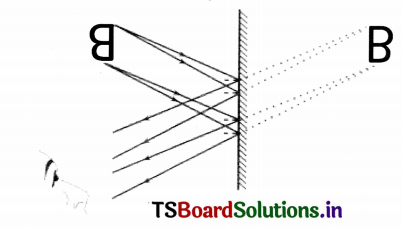
Question 4.
Why can’t we see our image in a white sheet of paper though it reflects light?
Answer:
- Reflection of light takes place on every’ opaque substance.
- In case of white paper sheet, it reflects light only.
- You can form image on a paper with the directions of light rays.
- That image is only drawn on paper sheet.
- It is neither real nor virtual.
- So, we cannot see the image there
- Whereas the image formed by a plane mirror is virtual.
- So, we cannot see the image on white paper though it reflects light.
Question 5.
Discuss the merits and demerits of using mirrors in building elevation?
Answer:
Merits:
- Mirrors can be cut into different shapes or sizes.
- Mirrors do not rust.
- Mirrors do not let water to pass through them.
Demerits:
- Elevation with mirrors is very expensive.
- Mirrors break very easily.
- Mirrors may melt at high temperatures.
III. Heigher Order Thinking Questions.
Question 1.
Observe the adjacent figure. AB and BC are two plane mirrors arranged at 1200. A ray incident at and angle 550 on AB. Find the value of ’x’?
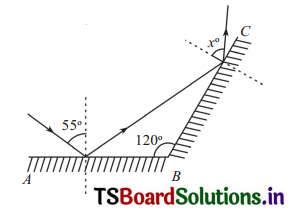
Answer:
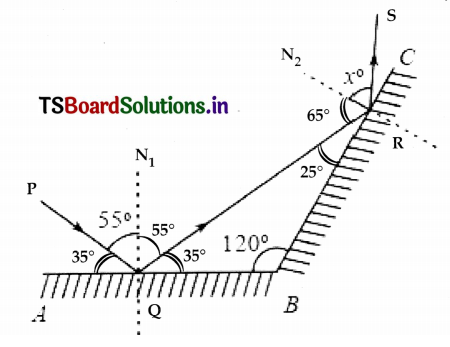
Here given ∠PQN1 =‘55° (angle of incidence) ∴ ∠ N1QR = 55° (angle of reflection)
∴ Glancing angles ∠AQP = 90° – 55 = 35° ∠RQB = 35°
Now in Δle QBR = ∠Q+ ∠B + ∠R =180°
∴ Second angle of incidence is 90° – 25° = 65°
∴ 35+120 =∠R = 180°⇒ ∠R = 25°
Since angle of incidence is equal to angle of reflection, we can say x = 65° and we can also ∠SRC = 90° – 65° = 25°
Question 2.
Niharika holds a clock in her hand, which shows the time 3’o clock. If she observes the clock in a plane mirror, what will be the time that the clock show In the plane mirror?
Answer:
If the time in clock = x
The formula for the time in the plane mirror = 12- x
∴ 3’ o clock in her wristwatch is nothing but 12 – x = 9’ o clock in the mirror.
Question 3.
Two plane mirrors are fixed at right angles to each other and an object is placed between them as shown in the figure. Trace the path of the rays by which an observer A
see the final image in one of the mirrors.
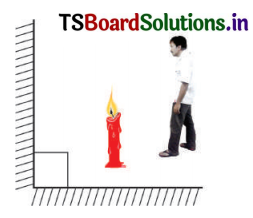
Answer:
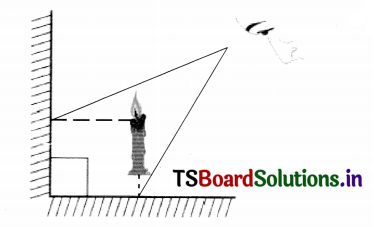
Question 4.
Two divergent rays originating from the same point have an angle of 10°. between them. If they strike a plane mirror with same Incident angles, what will be the angles of reflection?
Answer:

Here if we draw normals at the point of incidence we can find angles of incidence and reflection.
Here OA and N1N11 are parallel.
∴ OP is transversal line
∴ Angle of incidence = 5° and angle of reflection = 25°.
Multiple choice questions
Question 1.
Angle of incidence Angle of reflection. This rule is explained by …………………. principle. [ ]
(A) Format
(B) Newton
(C) Archimedes
(D) Pascal
Answer:
(A) Format
Question 2.
Which of the following letters doesn’t suíler lateral inversion. [ ]
(A) C
(B) O
(C) B
(D) N
Answer:
(B) O
Question 3.
A ray of light incidents on a plane mirror at an angle of 90° to its surface. What will be the angle of reflection? [ ]
(A) 0°
(B) 90°
(C) 45°
(D) 180°
Answer:
(A) 0°
Question 4.
If we move an object away from the plane mirror the size of images seems to be [ ]
(A) Increases
(B) decreased
(C) of the same size
(D) Image can’t be seen
Answer:
(B) decreased
Question 5.
Which of the following is incorrect with respect to the image in a plane mirror? [ ]
(A) Image is erect
(B) Size of the image is same as the size of object
(C) Laterally Inverted
(D) Image is real
Answer:
(B) Size of the image is same as the size of object
(C) Laterally Inverted
Suggested Experiments
Question 1.
Verify laws of reflection experimentally.
Answer:
Aim: Verification of 1st law of reflection.
Required material: Mirror strip, drawing board, plane mirror, pins, clamps, scale, and pencil.
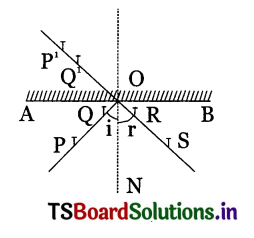
Procedure:
- Take a drawing board and fix a plane mirror on it with the help of clamps.
- Draw a straight line AB along the mirror and also a normal (ON) to AB at the point ‘O’.
- Draw a straight line PQ making certain angle (i) with ON as shown.
- Fix two pins the point P and Q on the paper vertically.
- Observe the image P1 of the pin P and Q1 of the pin Q, in the mirror kept along the line AB.
- Fix two more pins R and S such that they are in the same line as that P1 and Q1.
- Join R, S, and O as shown.
Observation: The angle between RS and ON is almost same as that of PQ and ON i.e. the angle of incidence = angle of reflection. Repeat the experiment with different angles of incidence and measure the corresponding angles of reflection.
Conclusion: In all observations, the angle of incidence is equal to the angle of reflection. Hence first law of reflection is verified.
ii) Aim: Verification of 2nd law of reflection.
Required material: Mirror strip, drawing board, plane mirror, pins, clamps, scale, and pencil.
Procedure:
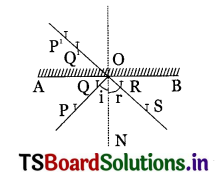
- Take a drawing board and fix the plane mirror on it with the help of clamps.
- Draw a straight line AB along the mirror and also a normal (ON) to AB at the point ‘O’.
- Draw a straight line PQ making certain angle (1) with ON as shown.
- The incident ray is the ray which is passing through the points “P” and “Q” touching the paper.
- The reflected ray is the ray which is passing through the points “R” and “S” touch the same paper and ON is the normal to the mirror point O.
Observation: The incident ray and reflected ray are in the plane parallel to the plane of the paper. Repeat the experiment with different angles of incidence.
Conclusion: In all observations incident ray and reflected ray and normal are lie in the same plane. Hence 2nd’ law of reflection is verified.
Question 2.
Find the plane of reflection experimentally for the incident ray which passes through
the heads of the pins pierced in front of the mirror as shown in figure 8.
Answer:
Aim: To find the plane of reflection for the incident ray which is passed through head of pins pierced infront of mirror.
Required material: Mirror strip, drawing board, a plane mirror, pins, clamps, scale and pencil.
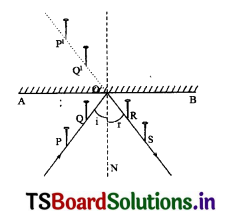
Procedure:
- Take a drawing board and fix a plane mirror on it with the help of clamps.
- Draw a straight line AB along the mirror and also a normal (ON) point ‘O’.
- Draw a straight line PQ making certain angle (i) with ON as shown.
- Fix two pins at the point of P and Q vertically.
- The incident ray is the ray which is passing through the points “P” and “Q” touching the mirror the reflected ray is the ray which is passing through the points “R” and “S” touching the same mirror and ON is normal to the mirror point at point ‘O’.
- The heads of all pins pierced at points P, Q, R, and S in this experiment are in the same height.
Observation: The incident ray is the ray which is passing through the heads of pins those are located at points P and Q and reflected ray is the ray which is passing through the heads of pins those are located at points R and S. The plane in which the incident ray and reflected ray and normal will lie in the plane of reflection.
Suggested Project Works
Question 1.
Make a solar heater! cooker with plane mirrors and write a report on the process of making.
Answer:
- Make a wooden or iron frame in the shape of a TV dish.
- Take acrylic mirror sheet and cut it into 8 or 12 pieces in the shape of triangles with a
height equal to the radius of TV dish. - The bases of the triangles together make the circumference of the dish.
- Stick the triangle mirror sheets to the dish.
- This act as solar cooker/heater.
- Arrange this solar cooker so that concave part faces the Sun.
- Find its focal point and place a vessel at that point.
- It will get heated. We can even cook rice in that vessel.

Question 2.
Generally, periscopes are made in the shape of “Z” make your own periscope in the shape of” C”. Discuss the problems faced while using the periscope you made in shape “C”. Draw the ray diagram to explain the formation of image in shaped periscope.
Answer:
- Periscope works on the principle of reflection.
- When it is in “Z” shape the light rays get reflected at the corners twice and final light ray emerges easily.
- If it is taken in ‘C’ shape; the reflected light would not go in some other direction.
- The purpose of periscope is to view the images of objects secretly.
- If you take it in ‘Z’ shape we can see the changes of the objects which cannot be seen directly.
TS 8th Class Physics 6th Lesson Reflection of Light at Plane Surfaces Intext Questions
Think and Discuss
Question 1.
In a pinhole camera experiment does the explanation match your observation? (Text. P.No. 85)
Answer:
Yes, the pinhole camera forms a real, inverted and diminished image, if the object is far away.
Question 2.
What happens ¡f the hole ¡s much bigger i.e. equal to the size of the flame?
Answer:
If the size of the hole is equal to size of the flame, no image is formed on the screen due to the overlapping of light rays from different parts of the object.
Question 3.
If so, can we get an image of a flame on the screen of the pinhole camera? Why?
Answer:
We can get the image of the flame in a pinhole camera provided the hole is small enough.
Question 4.
What happens if we observe the same flame with the same pinhole camera from a long distance?
Answer:
The size of the image depends on its distance. So, we see a smaller image if it is observed from a longer distance.
TS 8th Class Physics 6th Lesson Reflection of Light at Plane Surfaces Activities
Activity-1:
Question 1.
Describe an activity to explain the process of formation of image by a pinhole camera. (Text. P.No. 84)
Answer:
Refer Q.No. 3 in ‘Reflections on concepts.
Activity-2: (Text. P.No. 85)
Question 2.
What is the Fermat principle? Prove it by a small activity.
Answer:
- A smart crow is on a tree at point ‘A’ as shown in figure-1. Some grains are on the ground.
- If the crow wants to take a grain and reach the point ‘Won the other tree as early as possible (in the least time)
- The crow can pick the grain from any point on the ground but the condition is; selecting a point on the ground to reach point ‘B’ from points A in the least possible time.
- If we assume that the speed of the crow is constant the path that the crow selects should be the shortest.

By observing all figures, path AEB is the shortest path to reach point B from A. It would take the least time. So the smart crow will pick the grain from point E. If we draw a normal EE1 at point E, we can easily find the angle AEE’ is equal to angle EEB. Light also selects the path which takes the least time to travel. This is the Fermat principle.
Activity-3:
Question 3.
Check your understanding of reflection. (Text. P.No. 87)
Answer:
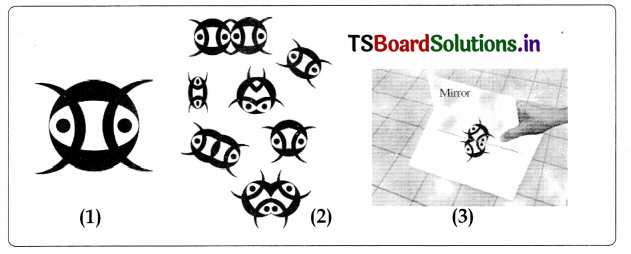
- Look at the figures (1) and (2).
- Let us suppose that have been given a plane mirror strip.
- We can observe figure (2) from (1) by placing the plane mirror in such a manner we can see in figure (3).
Lab Activity
Question 1.
Verify the laws of reflection through an activity. (Text. P.No. 87)
Answer:
Aim: Verification of V law of reflection.
Required material: Mirror strip, drawing board, plane mirror, pins, clamps, scale, and pencil.

Procedure:
- Take a drawing board and fix a plane mirror on it with the help of clamps.
- Draw a straight line AB along the mirror and N also a normal (ON) to AB at the point ‘O’.
- Draw a straight line PQ making certain angle (i) with ON as shown.
- Fix two pins the point P and Q on the paper vertically.
- Observe the image P1 of the pin P and Q1 of the pin Q, in the mirror kept along the line AB.
- Fix two more pins R and S such that they are in the same line as that P1 and Q1.
- Join R, S and O as shown.
Observation: The angle between RS and ON is almost same as that of PQ and ON i.e. the angle of incidence = angle of reflection. Repeat the experiment with different angles of incidence and measure the corresponding angles of reflection.
Conclusion: In all observations, the angle of incidence is equal to the angle of reflection. Hence first law of reflection is verified.
Question 2.
How do you verify the 2nd law of reflection of light with an experiment?
Answer:
Aim: Verification of 2nd law of reflection.
Required material: Mirror strip, drawing hoard, plane mirror, pins, clamps, scale, and pencil.
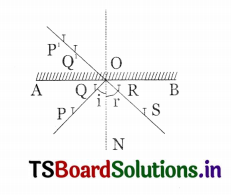
Procedure:
- Take a drawing board and fix the plane mirror on it with the help of clamps.
- Draw a straight line AB along the mirror and also a normal (ON) to AB at the point ‘O’.
- Draw a straight line PQ making certain angle (i) with ON as shown.
- The incident ray is the ray which is passing through the points “P” and “Q” touching the paper.
- The reflected ray is the ray’ which is passing through the points “R” and “S” touch the same paper and ON is the normal to the mirror point O.
Observation: The incident ray and reflected ray are in the plane parallel to the plane of the paper. Repeat the experiment with different angles of incidence.
Conclusion: In all observations incident ray and reflected ras’ and normal are lie in the same plane. Hence 2nd law of reflection is verified.
Problems
Question 1.
if the radius of curvature of a spherical mirror is 20cm, what is its focal length?
Solution:
Radius of the curvature R = 20 cm
We know that focal length
f = \(\frac{\mathrm{R}}{2}=\frac{20}{2}\) cm
∴ f = 10 cm
Thus, the focal length of this spherical mirror is 10 cm.
Question 2.
Find the size, nature and position of image formed when an object of size 1 cm is placed at a distance of 15 cm from a concave mirror of focal length 10 cm.
Solution:
Position of image:
Object distance u = —15 cm (To the left to mirror)
Focal length f = – 10 cm (it is concave mirror)
image distance v = ?
We know that \(\frac{1}{\mathrm{f}}=\frac{1}{\mathrm{u}}+\frac{1}{\mathrm{v}} \)
⇒ \(\frac{1}{\mathrm{v}}=\frac{1}{\mathrm{f}}-\frac{1}{\mathrm{u}}=\frac{1}{-10}-\frac{1}{-15}\)
= \(\frac{-1}{10}+\frac{1}{15}=\frac{-3+2}{30}=\frac{-1}{30}\)
∴ v = -30
Thus, the position of image is 30cm to the left side of mirror.
Nature of image: Since the image is formed in front of the concave mirror, it will be real and inverted,
Size of image:
Magnification, m = \(-\frac{\mathrm{v}}{\mathrm{u}} \)
v = -30 cm
u = -15 cm
m = \(-\left(\frac{30}{15}\right)\)
We know that magnification m = \(\frac{\mathrm{h}_2}{\mathrm{~h}_1}\)
Where h1 = height of the object = 1 cm
h2 = height of the image =?
m = -2,then
h2 = m × h<sub<1
= -2 × 1 cm
∴ h2 = -2 cm
Thus the size of the image is 2 cm long. So magnified image is formed.
Question 3.
A concave mirror produces three times magnified real image of an object placed at 10 cm in front of it. Where is the image located?
Solution:
Magnification m = -3 (image is real)
Object distance u = – 10 cm (To the left of mirror)
Image distance v =?
We know m = \(-\frac{v}{u} \)
⇒ v = m × -u
= -3 × (-10)
= -3 × 10
∴ v = -30 cm
Thus, the image is located at a distance of 30 cm in front of the mirror.
Question 4.
An object is placed at a distance of 2m from a plane mirror. Find the image distance and magnification produced.
Solution:
Object distance: u = 2m
Mirror formula: \(\frac{1}{v}+\frac{1}{u}=\frac{1}{f}\)
For a plane mirror: f is an infinity
\(\frac{1}{v}+\frac{1}{u}=\frac{1}{\infty}\) = 0
\(\frac{1}{\mathrm{v}}=\frac{1}{\mathrm{u}} \)
⇐ v = -u
– ve symbol indicates the image is formed behind (in) the mirror.
So, image distance: v = 2m
Linear magnifkation : m = \(\frac{\dot{\mathrm{v}}}{\mathrm{u}}=\frac{2}{2} \) = 1
So, a plane mirror does not magnify the image.
Question 5.
An image Is formed at a distance of 10 cm from the pole of a convex mirror of focal length 20 cm. Find the position of the object.
Solution:
Image distance: v = 10cm
Focal length : f = 20cm
Object distance: u =?
sign convention
u – ve; v + ve, +ve
Mirror formula:
\(\frac{1}{\mathrm{u}}=\frac{1}{\mathrm{f}}-\frac{1}{\mathrm{v}}\)
= \(\frac{1}{20}-\frac{1}{10}\)
\(\frac{1}{u}=\frac{1-2}{20}=\frac{-1}{20}\)
u = 20
∴ Obfrct is placed 20cm before the mirror,
Question 6.
The focal length of a spherical minor is 25cm. What is its radius of curvature?
Solution:
Focal length of the mirror: f = 25cm
Radius of curvature: R = 2f
= 2 × 25 = 50cm
R = 50cm
Question 7.
Where should an object be placed to obtain the image at same position for a concave mirror of radius of curvature 40cm?
Solution:
Focal length:
f = \(\frac{\mathrm{R}}{2}=\frac{40}{2}\)= 20 cm
\(\frac{1}{\mathrm{f}}=\frac{1}{\mathrm{v}}+\frac{1}{\mathrm{u}}\)
Object distance :
\(\frac{1}{f}=\frac{1}{v}+\frac{1}{u}=\frac{2}{u} \)
u = v
u = 2f
= 2 × 20 = 40 cm
∴ An object should be placed at 40 cm
Question 8.
An object of height 1 cm is placed in front of a concave mirror of focal length 10 cm, such that a virtual image is formed. If the height of the image is 3 cm, find the object
distance.
Solution:
Height of the object; h0 = 1 cm
Height of the image: hi = 3cm
Magnification = \(\frac{\mathrm{v}}{\mathrm{u}}\)
\(\frac{\mathrm{v}}{\mathrm{u}}\) = 3 ⇒ v = 3u
Magnification : m = \(\frac{\mathrm{h}_{\mathrm{i}}}{\mathrm{h}_0}=\frac{3}{1} \) = 3
Focal length of the mirror: f = 10cm
Mirror formula; \(\frac{1}{v}+\frac{1}{u}=\frac{1}{f} \)
Sign convention : u – ve; f-ve; v + ve
\(\frac{1}{\mathrm{v}}-\frac{1}{\mathrm{u}}=-\frac{1}{\mathrm{f}} ; \frac{1}{\mathrm{u}}=\frac{1}{\mathrm{v}}+\frac{1}{\mathrm{f}}\)
\(\frac{1}{u}=\frac{1}{3 u}+\frac{1}{f} \)
\(\frac{1}{10}=\frac{1}{u}-\frac{1}{3 u}=\frac{3-1}{3 u}=\frac{2}{3 u}\)
3u=20u ⇒ u = \(\frac{20}{3}\) = 6.67cm
Question 9.
What is the range of object distances for the formation of diminished image, by a concave mirror of focal length 30cm?
Solution:
A diminished image is formed by a concave mirror when the object is placed between infinity and center of curvature.
So, the range is infinity to 2f
R = infinity to 2f
Range: ∝ to 60 cm